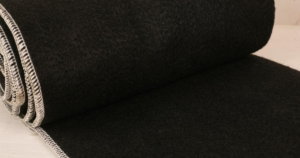Silt is dense, dust-like silt that is transported and deposited by water, ice, and wind. Silt consists of small particles or grains of soil and minerals that are easily carried and deposited by water. Each particle is smaller than a grain of sand but larger than a clay particle.
When heavy rains pound the soil some of these fine granular particles are carried by the runoff water as silt. Silt carried by water runoff is deposited in lowlands, rivers, or ponds as sediment. The environmental impact of silt is enormous, as once it settles into a river or lowland it provides valuable nutrients for plants and insects in the sediment it creates.
Silty soil often has a higher fertility level than other types of soil, making it suitable for agricultural cultivation. Silt helps with both air flow and water retention. Insufficient clay might make the soil too hard for plants to grow in. Agriculture has flourished in many regions of the world in river deltas with abundant silt deposits and along river banks with silt that is replenished annually by floods.
Due to its protracted capacity to hold water, silt, like peat, is an inferior soil choice for constructing a foundation. Due to the shifting and expanding effects of the silt, which is caused by this property, the building is repeatedly subjected to long-term stress and is left without any support. Structures may be harmed or fail as a result of this.
About Soil Texture
The sizes of the mineral particles in soil affect the texture of that soil. The mineral particles that makeup soil, such as sand, silt, and clay, are produced from rock that has been eroded over millions of years by climatic and environmental factors (rain, glaciers, wind, rivers, animals, etc.).
- Sand is a mineral with the biggest and coarsest particles. When rubbed between your fingertips, these particles, which range in size from 2.00 to 0.05 mm, feel gritty.
- Silt particles have a dry weight equivalent to wheat and range in size from 0.05 to 0.002 mm.
- More than 0.002 mm across, clay particles are very tiny. They cluster to the point that you need a microscope to see a single particle, making them feel sticky in your fingers when moist.
Importance of Sand in Construction
At each construction site, sand or fine aggregate is one of the most crucial building components. Given that it helps make key combinations like concrete, plaster, and mortar stronger, it is crucial to choose it properly. Sand needs to be checked for the presence of clay, silt, moisture, and other harmful substances (salts, coal, mica), which might influence the strength of construction and result in unnecessary rework.
Particle sizes in suitable building sand range from 150 microns to 4.75 mm. Silt is a category for tiny particles. Sand with excessive amounts (> 8%) of silt lowers the ability of raw materials to link together, which has an impact on the durability and strength of the construction. For every 20m3 of sand, it is advised to do a silt content test.
Silt particles increase the total surface area and, as a result, require more water to mix the plaster mortar, which reduces the mortar’s strength.
Second, regardless of the age of the mortar, silt particle form and makeup do not contribute to enhancing mortar strength.
Having stated that, a specific silt concentration is necessary for plastering to operate and produce as needed. According to my experience, plastering is best done with a silt level between 7 and 10%.
How does Silt Affect the Plastering Mix?

Before plastering, it is advised to use a 1:4 mix ratio with extra water put into it on the surface of the wall or roof that will be plastered (a layer is formed). Then, typically, a layer with very little water (1:6) forms (like wet sand). After that, you may use a straightedge to get the necessary thickness.
For interior brick plastering, the cement to fine aggregate ratio should be 1:6, while for exterior slathering, it should be 1:4. Never plaster a brick wall with a thickness of more than 12 or 15 mm. Never plaster concrete more than 6 mm thick all at once.
Depending on availability, one should switch over the past few years to using Robo sand, artificial sand, crushed stone sand, quarry dust, and M sand for plastering. However, one should still make sure to add an additive at 500ml per bag of cement that can tolerate such silt content without affecting the quality of the plaster.
You obtain a solid, waterproof plaster that is free of fissures. Additionally, you benefit from this in that you gain strong bonding and workability.
It will shrink or grow in response to a change in the water content, depending on whether that change was for the better or worse. Because of this and the fact that it has a greater propensity for water, you must raise the water content. Additionally, from a strength standpoint, the concrete will get weaker.
This is because, in the past, several tests involving the substitution of sand with silt have been conducted; however, only up to 5% of silt resulted in an increase in strength before the strength began to decline. For this reason, the majority of codes include a 5% silt restriction. Additionally, using silt weakens the link between the rebars and concrete, preventing them from adhering properly.
It is best to avoid using silt as a substitute for sand since, when all the factors mentioned above are taken into account, the gain in hardness is not that great and it compromises the longevity of the concrete.
In the making of concrete, silt creates some disadvantages which are-
- Because silt absorbs more water, there is a danger that there won’t be enough water to completely hydrate the cement. As a result, the concrete will start to crack.
- Salts and volatile substances might be present in silt.
- More flexibility and fluidity will cause concrete to crumble as a result.
- Silent on its own does not have good strength and compactness. Concrete will get weaker as a result.
- Additionally, its crystal structure of it is poor.
But in the end, you will need silt nonetheless to make concrete but you need to maintain the ratio.
Silt is a tricky substance. So it’s better to get enough knowledge so that you can understand if you need silt for the plaster mix or not.

